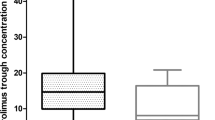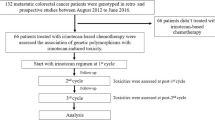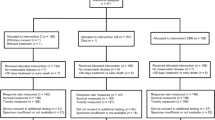Abstract
Previously studied candidate genes have failed to account for inter-individual variability of docetaxel and doxorubicin disposition and effects. We genotyped the transcriptional regulators of CYP3A and ABCB1 in 101 breast cancer patients from 3 Asian ethnic groups, that is, Chinese, Malays and Indians, in correlation with the pharmacokinetics and pharmacodynamics of docetaxel and doxorubicin. While there was no ethnic difference in docetaxel and doxorubicin pharmacokinetics, ethnic difference in docetaxel- (ANOVA, P=0.001) and doxorubicin-induced (ANOVA, P=0.003) leukocyte suppression was observed, with Chinese and Indians experiencing greater degree of docetaxel-induced myelosuppression than Malays (Bonferroni, P=0.002, P=0.042), and Chinese experiencing greater degree of doxorubicin-induced myelosuppression than Malays and Indians (post hoc Bonferroni, P=0.024 and 0.025). Genotyping revealed both PXR and CAR to be well conserved; only a PXR 5′-untranslated region polymorphism (−24381A>C) and a silent CAR variant (Pro180Pro) were found at allele frequencies of 26 and 53%, respectively. Two non-synonymous variants were identified in HNF4α (Met49Val and Thr130Ile) at allele frequencies of 55 and 1%, respectively, with the Met49Val variant associated with slower neutrophil recovery in docetaxel-treated patients (ANOVA, P=0.046). Interactions were observed between HNF4α Met49Val and CAR Pro180Pro, with patients who were wild type for both variants experiencing least docetaxel-induced neutropenia (ANOVA, P=0.030). No other significant genotypic associations with pharmacokinetics or pharmacodynamics of either drug were found. The PXR-24381A>C variants were significantly more common in Indians compared to Chinese or Malays (32/18/21%, P=0.035) Inter-individual and inter-ethnic variations of docetaxel and doxorubicin pharmacokinetics or pharmacodynamics exist, but genotypic variability of the transcriptional regulators PAR, CAR and HNF4α cannot account for this variability.
This is a preview of subscription content, access via your institution
Access options
Subscribe to this journal
Receive 6 print issues and online access
$259.00 per year
only $43.17 per issue
Buy this article
- Purchase on Springer Link
- Instant access to full article PDF
Prices may be subject to local taxes which are calculated during checkout

Similar content being viewed by others
Accession codes
References
Hesselink DA, van Schaik RH, van der Heiden IP, van der Werf M, Gregoor PJ, Lindemans J et al. Genetic polymorphisms of the CYP3A4, CYP3A5, and MDR-1 genes and pharmacokinetics of the calcineurin inhibitors cyclosporine and tacrolimus. Clin Pharmacol Ther 2003; 74: 245–254.
Xie HG, Wood AJ, Kim RB, Stein CM, Wilkinson GR . Genetic variability in CYP3A5 and its possible consequences. Pharmacogenomics 2004; 5: 243–272.
Kajinami K, Brousseau ME, Ordovas JM, Schaefer EJ . CYP3A4 genotypes and plasma lipoprotein levels before and after treatment with atorvastatin in primary hypercholesterolemia. Am J Cardiol 2004; 93: 104–107.
Ozdemir V, Kalowa W, Tang BK, Paterson AD, Walker SE, Endrenyi L et al. Evaluation of the genetic component of variability in CYP3A4 activity: a repeated drug administration method. Pharmacogenetics 2000; 10: 373–388.
Sakaeda T, Nakamura T, Okumura K . Pharmacogenetics of MDR1 and its impact on the pharmacokinetics and pharmacodynamics of drugs. Pharmacogenomics 2003; 4: 397–410.
Yi SY, Hong KS, Lim HS, Chung JY, Oh DS, Kim JR et al. A variant 2677A allele of the MDR1 gene affects fexofenadine disposition. Clin Pharmacol Ther 2004; 76: 418–427.
Kim RB, Leake BF, Choo EF, Dresser GK, Kubba SV, Schwarz UI et al. Identification of functionally variant mdr1 alleles among European Americans and African Americans. Clin Pharmacol Ther 2001; 70: 189–199.
Goh BC, Lee SC, Wang LZ, Fan L, Guo JY, Lamba J et al. Explaining interindividual variability of docetaxel pharmacokinetics and pharmacodynamics in Asians through phenotyping and genotyping strategies. J Clin Oncol 2002; 20: 3683–3690.
Kliewer SA, Moore JT, Wade L, Staudinger JL, Watson MA, Jones SA et al. An orphan nuclear receptor activated by pregnanes defines a novel steroid signaling pathway. Cell 1998; 92: 73–82.
Goodwin B, Redinbo MR, Kliewer SA . Regulation of cyp3a gene transcription by the pregnane X receptor. Annu Rev Pharmacol Toxicol 2002; 42: 1–23.
Kliewer SA, Goodwin B, Willson TM . The nuclear pregnane X receptor: a key regulator of xenobiotic metabolism. Endocr Rev 2002; 23: 687–702.
Willson TM, Kliewer SA . PXR, CAR and drug metabolism. Nat Rev Drug Discov 2002; 1: 259–266.
Tirona RG, Lee W, Leake BF, Lan LB, Cline CB, Lamba V et al. The orphan nuclear receptor HNF4alpha determines PXR- and CAR-mediated xenobiotic induction of CYP3A4. Nat Med 2003; 9: 220–224.
Wang H, LeCluyse EL . Role of orphan nuclear receptors in the regulation of drug-metabolising enzymes. Clin Pharmacokinet 2003; 42: 1331–1357.
Jiang G, Sladek FM . The DNA binding domain of hepatocyte nuclear factor 4 mediates cooperative, specific binding to DNA and heterodimerization with the retinoid X receptor alpha. J Biol Chem 1997; 272: 1218–1225.
Jover R, Bort R, Gomez-Lechon MJ, Castell JV . Cytochrome P450 regulation by hepatocyte nuclear factor 4 in human hepatocytes: a study using adenovirus-mediated antisense targeting. Hepatology 2001; 33: 668–675.
Lausen J, Thomas H, Lemm I, Bulman M, Borgschulze M, Lingott A et al. Naturally occurring mutations in the human HNF4alpha gene impair the function of the transcription factor to a varying degree. Nucleic Acids Res 2000; 28: 430–437.
Lamba J, Lamba V, Schuetz E . Genetic variants of PXR (NR1I2) and CAR (NR1I3) and their implications in drug metabolism and pharmacogenetics. Curr Drug Metab 2005; 6: 369–383.
Andersen A, Holte H, Slordal L . Pharmacokinetics and metabolism of doxorubicin after short-term infusions in lymphoma patients. Cancer Chemother Pharmacol 1999; 44: 422–426.
Clarke SJ, Rivory LP . Clinical pharmacokinetics of docetaxel. Clin Pharmacokinet 1999; 36: 99–114.
Zhang J, Kuehl P, Green ED, Touchman JW, Watkins PB, Daly A et al. The human pregnane X receptor: genomic structure and identification and functional characterization of natural allelic variants. Pharmacogenetics 2001; 11: 555–572.
Bosch TM, Deenen M, Pruntel R, Smits PH, Schellens JH, Beijnen JH et al. Screening for polymorphisms in the PXR gene in a Dutch population. Eur J Clin Pharmacol 2006; 62: 395–399.
Koyano S, Kurose K, Ozawa S, Saeki M, Nakajima Y, Hasegawa R et al. Eleven novel single nucleotide polymorphisms in the NR1I2 (PXR) gene, four of which induce non-synonymous amino acid alterations. Drug Metab Pharmacokinet 2002; 17: 561–565.
Lee SC, Ng SS, Oldenburg J, Chong PY, Rost S, Guo JY et al. Interethnic variability of warfarin maintenance requirement is explained by VKORC1 genotype in an Asian population. Clin Pharmacol Ther 2006; 79: 197–205.
Ek J, Rose CS, Jensen DP, Glumer C, Borch-Johnsen K, Jorgensen T et al. The functional Thr130Ile and Val255Met polymorphisms of the hepatocyte nuclear factor-4alpha (HNF4A): gene associations with type 2 diabetes or altered beta-cell function among danes. J Clin Endocrinol Metab 2005; 90: 3054–3059.
Pruhova S, Ek J, Lebl J, Sumnik Z, Saudek F, Andel M et al. Genetic epidemiology of MODY in the Czech republic: new mutations in the MODY genes HNF-4alpha, GCK and HNF-1alpha. Diabetologia 2003; 46: 291–295.
Green VJ, Kokkotou E, Ladias JA . Critical structural elements and multitarget protein interactions of the transcriptional activator AF-1 of hepatocyte nuclear factor 4. J Biol Chem 1998; 273: 29950–29957.
Eeckhoute J, Formstecher P, Laine B . Maturity-onset diabetes of the young Type 1 (MODY1)-associated mutations R154X and E276Q in hepatocyte nuclear factor 4alpha (HNF4alpha) gene impair recruitment of p300, a key transcriptional co-activator. Mol Endocrinol 2001; 15: 1200–1210.
Eeckhoute J, Moerman E, Bouckenooghe T, Lukoviak B, Pattou F, Formstecher P et al. Hepatocyte nuclear factor 4 alpha isoforms originated from the P1 promoter are expressed in human pancreatic beta-cells and exhibit stronger transcriptional potentials than P2 promoter-driven isoforms. Endocrinology 2003; 144: 1686–1694.
Kistanova E, Dell H, Tsantili P, Falvey E, Cladaras C, Hadzopoulou-Cladaras M . The activation function-1 of hepatocyte nuclear factor-4 is an acidic activator that mediates interactions through bulky hydrophobic residues. Biochem J 2001; 356: 635–642.
Zhu Q, Yamagata K, Miura A, Shihara N, Horikawa Y, Takeda J et al. T130I mutation in HNF-4alpha gene is a loss-of-function mutation in hepatocytes and is associated with late-onset Type 2 diabetes mellitus in Japanese subjects. Diabetologia 2003; 46: 567–573.
Bosch TM, Huitema AD, Doodeman VD, Jansen R, Witteveen E, Smit WM et al. Pharmacogenetic screening of CYP3A and ABCB1 in relation to population pharmacokinetics of docetaxel. Clin Cancer Res 2006; 12: 5786–5793.
Guitton J, Cohen S, Tranchand B, Vignal B, Droz JP, Guillaumont M et al. Quantification of docetaxel and its main metabolites in human plasma by liquid chromatography/tandem mass spectrometry. Rapid Commun Mass Spectrom 2005; 19: 2419–2426.
Andersen A, Warren DJ, Slordal L . A sensitive and simple high-performance liquid chromatographic method for the determination of doxorubicin and its metabolites in plasma. Ther Drug Monit 1993; 15: 455–461.
Acknowledgements
This work was supported by grants from the Biomedical Research Council of Singapore (BMRC 01/1/26/18/060) and Singapore Cancer Syndicate (SCS-PN0022).
Author information
Authors and Affiliations
Corresponding author
Additional information
Duality of Interest
All authors declare no conflict of interest.
Rights and permissions
About this article
Cite this article
Hor, S., Lee, S., Wong, C. et al. PXR, CAR and HNF4α genotypes and their association with pharmacokinetics and pharmacodynamics of docetaxel and doxorubicin in Asian patients. Pharmacogenomics J 8, 139–146 (2008). https://doi.org/10.1038/sj.tpj.6500478
Received:
Revised:
Accepted:
Published:
Issue Date:
DOI: https://doi.org/10.1038/sj.tpj.6500478
Keywords
This article is cited by
-
Natural compounds targeting nuclear receptors for effective cancer therapy
Cancer and Metastasis Reviews (2023)
-
Impact of gene polymorphisms on the systemic toxicity to paclitaxel/carboplatin chemotherapy for treatment of gynecologic cancers
Archives of Gynecology and Obstetrics (2019)
-
High-throughput pharmacogenetics identifies SLCO1A2 polymorphisms as candidates to elucidate the risk of febrile neutropenia in the breast cancer RAPP-01 trial
Breast Cancer Research and Treatment (2015)
-
Pharmacogenomic diversity in Singaporean populations and Europeans
The Pharmacogenomics Journal (2014)
-
Clinical efficacy of adjunctive G-CSF on solid tumor and lymphoma patients with established febrile neutropenia
Supportive Care in Cancer (2014)



